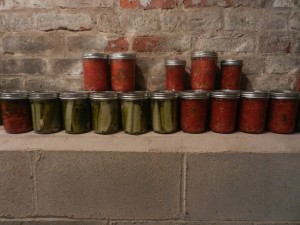 If you’ve read and understand the importance of having a long-term food storage plan, but don’t quite know where to start, you’re not alone. Food storage and survival preparation is a comprehensive subject and there can be a lot to learn. So today I thought I’d go over some basics, a food storage 101, so to speak.
If you’ve read and understand the importance of having a long-term food storage plan, but don’t quite know where to start, you’re not alone. Food storage and survival preparation is a comprehensive subject and there can be a lot to learn. So today I thought I’d go over some basics, a food storage 101, so to speak.
What to Consider When Creating Your Long Term Food Storage Plan
Many times people planning for long term food storage in case of a disaster or other event simply fill up their basement with MRE’s, or some other form of dried up “foods” with a 30-year shelf life. While these products are definitely beneficial and have their place, we’ve chosen to go a different route for our food storage system.
As we considered and planned for our long term food storage system, we started out with food that was basic, cheap and had a long shelf life, such as rice and beans. Then, as my prepping friend Michelle pointed out in this post, we started to come to terms with the fact that we didn’t want to live on beans and rice for six months straight. No, we wanted our food storage system to consist of food we wanted to eat, and we wanted our system to have variety. So we revamped things and created, kind of like Lance did here, our own mini grocery store in our home. Here are some steps you can take to create a long term food storage plan, while still stockpiling the foods you love and will use.
1. Make a list of foods that you like to eat that have the capability of being stored long term. For instance, we don’t buy canned beets, because we all hate beets. Instead, when planning our stockpile, we wrote down a list of foods and meals that we like to eat, and we planned our food storage system accordingly, striking a balance between finding foods that have a longer shelf life and finding foods that we truly enjoy eating.
2. Create a mini grocery store in your home. In our home mini grocery store, we stack all of the foods neatly on shelves. We buy foods we eat regularly, and then when we replace something in the kitchen, say, refried beans, we’ll buy the number of cans of beans we need for the month, put those cans in our “store”, and take the same number of cans out of our store, ensuring that the food in long term storage gets rotated out regularly and doesn’t risk going past the expiration date. Just like a grocery store does, we put the oldest supplies in the front of the row, and the newest supplies in the back of the row.
3. Work to buy your storage items on sale. One of the keys to an affordable long term food storage plan is to buy on sale. For instance, when canned veggies go on sale, we load up. This way we’re getting the most for our money to make our food storage system as profitable as possible.
4. Don’t buy things just because they are on sale. When it comes to long term food storage, don’t buy 20 boxes of processed scalloped potatoes just because you got a “good deal” if you’re going to gag every time you try and eat them. Quality food storage is just as important as quantity.
Recommended Reading: 35 Survival Foods to Stockpile
5. Get to know shelf lives of different products. Start paying attention to the expiration dates of the different items your family eats, and make sure you have plenty of stuff that has longer drawn out expiration dates. Olives and black beans come to mind.
6. Utilize warehouse clubs. Clubs like Sam’s Club and Costco sell in large quantities and go through food really quickly, so you can be pretty sure you’re getting recently canned items that have a further away expiration date. Always know and check prices, though: not all warehouse club items are cheaper than the grocery stores.
7. Don’t forget condiments,spices and water. Can you imagine eating your meals for a month or longer without any seasonings or condiments? Our food stockpile is sure to contain things like salt, pepper, garlic powder, salsa, ketchup and mustard. Again, we largely utilize Sam’s Club and Costco for these items, due to the huge price savings. Also, make sure to have at least some bottled water on hand, or some other source of fresh clean water for your family to drink and cook with, in case water is contaminated or a power outage renders your water supply inaccessible, as is often the case with well water.
8. Consider including toiletries in your long term stockpile. Many people include soaps, shampoos, contact solution, over the counter meds and other necessities in their stockpiles. If for some reason you can’t or don’t want to leave the house for an extended period of time, you’ll be much more comfortable if you can shower with soap and use real toilet paper instead of having to find a substitute for these things.
9. Don’t feel like you need to tell the world. Unless you’re sharing because you’ve been asked, don’t feel the need to tell the world what you’ve got on hand and how much of it. It’s great to help educate others who truly want to be educated about stockpiling and preparation, but don’t make yourself an open target to those who simply want to know who to rob or mooch off of when and if the SHTF because they don’t feel the need to make their own plan.
10. Be smart, don’t be scared, and don’t be naive. The idea of creating a long-term food storage plan creates fear in some people, and denial in others. No need to panic and worry yourself that an apocalypse is coming, but at the same time, don’t be naive and assume that a storm, pandemic, terrorist attack or other trouble will never come to where you live. Events such as Hurricane Sandy proved that making and carrying out a plan for long term food storage is simply good sense. Lance mentioned in his post here that, similar to an emergency fund, a long-term food storage system makes life a whole lot easier in the case of a job layoff, storm or some other situation where making weekly trips to the grocery store is just not feasible.
I hope this post has helped answer at least some of your questions on how to get started with a long term food storage plan. Feel free to leave any comments or additional thoughts below.
*This post may contain affiliate links








Thank you for sharing this post Laurie. This is so true, you never know when you are going to need it. Whether a natural disaster or loss of a job.
Exactly, Brit! Best to be prepared.
Great tips here, Laurie – thank you! (And how can you not like beets??) 🙂
Everyone knows beets are gross. 😉
These are great tips. The condiments and spices are a great idea. Sometimes you stock up on what you like to eat but don’t put in food that kids are going to eat so you also want to factor that in as well. Plus you want to make sure you have all the utensils needed to prepare and cook your meals if the power or natural gas goes down. You may want to test it out for a day or two to see if you are really set to go and see if you can cook and survive a couple of days without your main appliances then it will really show you what what works and what you wish you had on hand during the emergency. And great tips on not worrying about what other people say, who cares it’s your life. This is like people in debt making fun of frugal and financially responsible because they don’t have a brand new car. You are right, I don’t have a new car, but my house is paid for and I have a monster bank account and investments…but thanks for watching out for me anyways 🙂
Lance, you’re so right. I wish more people would view debt that way.
Trust me I have had my share of MRE’s in my day. The only time they taste good is when you’re really hungry and there is nothing else to eat.
That’s what I hear. I’ll take my real food as first choice, thank you very much. 🙂
Planning to have a list of food that can be stored for long term. I have prepared some kimchi and plan to store more food to add in my mini collections. It is really fun, my kids help me!
Jayson, so excited for you that you are making and following through with a plan, and you’re right about the kids: they love this kind of stuff!
Great tips! I know that when I first started to randomly stock up on food, I brought stuff that I haven’t ever tried, but purchased it because it was cheap. Well, that food ended up in the trash when it eventually expired and now I’ve learned my lesson: only get stuff that you like to eat and rotate.
C, you’re on the right track – keep up the awesome work of taking care of your adorable family so well, my friend.
Helpful post! Will keep this in mind because I always have expiring items 🙁
Yep, use them up and buy more to replace them. 🙂
I am SO looking forward to starting my stockpile! Thanks for the comprehensive list, Laurie! (p.s. I’m with you on the beets. Yuckola!) 🙂
I’m so excited for you, Kay! And glad to have a fellow beet hater on board too. 😉
I love beets! Especially home canned ones. You’ve reminded me to be on the lookout for toothpaste on sale as we’ve worked through most of the tubes we had.
Yes, we do toothpaste stock ups too! My mom is a pro at this and gets most of her toothpastes for free with tricks like double coupon day.
My MIL loved pickled beets. UGH! Great point mentioning rotation. Otherwise you end up with a burst can of something in the back of your shelves. :0 Did you know that in cooking magazines they recommend you change spices every six months? Yikes, they are pretty expensive to begin with and if you don’t use up that unique spice you bought for one recipe, you are throwing away a whole bottle. I’ve found that they actually are good for much longer with no decrease in taste. And I especially agree with you on not broadcasting what you have stockpiled. Just like in Henny Penny, everyone will be expecting that they share in your fresh baked bread after you did all the work to acquire it.
Interesting about the spices, and I agree with you; we’ve found them to last just fine for a year or more. There’s a Twilight Zone episode where a bunch of neighbors, all good friends, tease one of the guys about all of the time he spends building his bomb shelter. Then the SHTF and suddenly they’re all begging him to let them in, but he’s only got enough oxygen/food/water for his family, and they all end up hating him. That’s what taught us to not be too specific about our disaster plans here at the house. 🙂
It is important to stock up on stuff you eat on the regular if on sale. Because you are giving the future you a raise next week by not buying that item later at a regular retail price. But the secret is that savings amount has to be saved or used against debt, or else you will spend it on other things. Don’t miss the opportunity, and follow the tips above.
Exactly, EL!! With food prices rising the way they are, it makes perfect sense.
This comes timely as I’m going to go in stockpile mode through the end of the year! Our space is limited, but I agree about buying things in bulk that is used regularly, like cereals, rice, canned tomatoes, canned beans, etc. We also hoard TP like crazy – I don’t know why, but I have a deep-seated fear of running out of that stuff! lol Oh, and care to share your chicken enchiladas recipe? 🙂
LOL, I hoard TP like crazy too!!!! This drives Rick crazy, as under our bed is filled with TP, but he’ll be glad one day if we ever have to go into disaster mode. 🙂 Yes!!! I will share it here on the site and email you. 🙂
Good tips! I do this to some degree too. My “excess” food is neatly organized by exp date so I can make sure to eat it before it goes bad. I also rotate by buying new to replace the “excess” stash and the “excess” goes to the kitchen to be used periodically. Thanks for sharing Laurie!
That’s the way to do it, Kayla! You are so on the right track.
Do you ever watch Doomsday Preppers? I love that show (it’s on Netflix) and some of those people have huge stockpiles of food! I think it’s a good idea if you are able to keep it from going bad.
Love that show! Although some of the people seem a little off their rockers. 🙂 Then again, the day might come when I wish we were as paranoid as they are, LOL.
We’re all coming to your house if something happens;0) I love how you keep it real. Storing food we actually like is key. I better stock up on ketchup … not sure what my son would do without it;0)
LOL, come on over, Jayleen! Funny about ketchup – our kids are ketchup fanatics too. 🙂
Great tips, Laurie! Numbers 7 and 8 are ones people overlook but would definitely miss if/when they ever needed to utilize their long-term supplies. I would also add a few basic things for your pets too. This is something I need to get better at overall and need to have a least a mini-stash set up for Max and myself. I don’t have a ton of space but I can still find a place to store some goods. And I agree – you don’t want to stock up on things you hate! 🙂
Yeah, we can’t forget our furbabies, that’s for sure. Gotta love ’em!